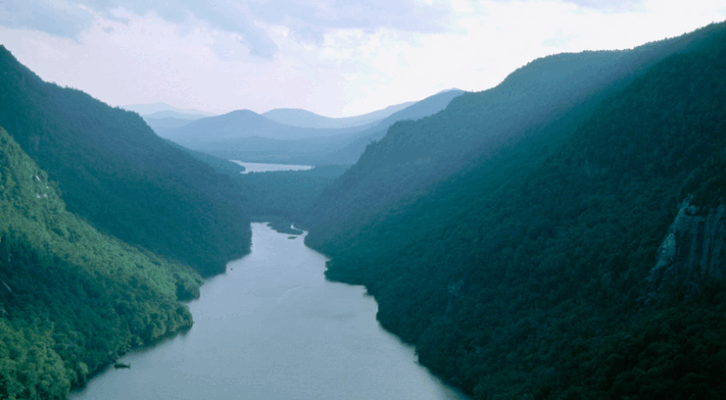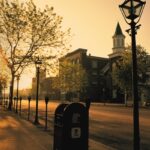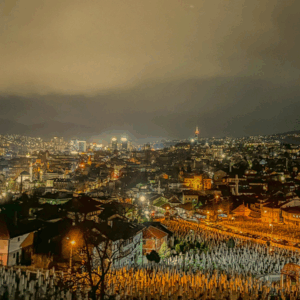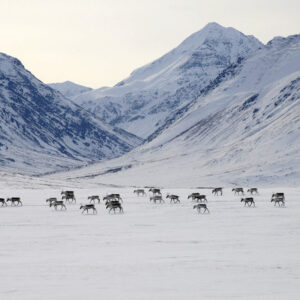
A Place of Healing: Robin Wall Kimmerer on the Medicinal Plants of the Adirondacks
"If we value the medicine the land offers us so generously, we must become medicine for the land."
Heading north, following the tang of boggy rivers and the sweetness of pines on the air, I like to imagine that I could smell my way home, like a salmon navigating to its natal stream. Closer and closer, the aroma draws me like a magnet…sun on granite, black humus, balsam fir, and a faint whiff of yellow birch smoke. When I was a little kid, in the wayback of our old red station wagon with a canoe on top, I’d watch as the farm fields disappeared and houses became few, the forest thicker and so fragrant I’d roll down the window to breathe it in. My dad would call out from the front, “We’re about to cross the Blue Line!” and I’d crane my neck to see it, looking for a painted trail through the woods or a line across the road. That boundary loomed large in my imagination. I’d come to know that everything was different on the inside of that line. I never saw it, but I always knew.
I remember the pride I felt when he explained that everything beyond that line, lakes and forests and trails heading off to someplace you wanted to go, all belonged to us. I felt unbelievably rich. With the mythos of public land, planted in my understanding, we were free to explore it all, unfettered. As we got older, I learned the origin of this legacy created through the Forever Wild amendment, which seemed to me the pinnacle of ethical behavior. We were grateful recipients of the foresight of thinkers before us, who gave priority to the life of the land. Every time we crossed the Blue Line, there was a sense of safety. Here was a place I could love with whole heart, without fear of losing it.
The Adirondacks continue to be a healing place, where we can recover from those stresses and learn from the land another way to live.
Sometimes, as we drove down a sandy woods road toward a camping place, my dad would glance off into the woods and ask us ever-gullible children, “Did you see it? We just passed Sunday Rock.” Indeed, the woods were full of glacial erratics, covered in blankets of moss, but I never knew which one it was. He was a great one for stories and building on the lore of a granite boulder said to mark the boundary between civilization and the wilds. He promised us that after you passed that rock, every day was Sunday. Here there was no workday, no school day, no time but the present. How a calendar could be abolished, I did not understand. My family was not much for religion or Sunday school, but as an Anishinaabe child, I knew that this was where spirit and praise rang through the woods, every single day. I was not wrong.
What is now called the Adirondack Park has long been shared homelands for multiple Indigenous Nations of the region—the Haudenosaunee, the Abenaki, Algonquin, and Anishinaabe peoples, who had a strong presence here. The rich gifts of this landscape supported Native peoples with fish, game, berries, furs, and especially medicine plants. Today, healers from these Nations continue to find the traditional medicines thriving here. Every landscape has its own pharmacy, but the ancient forests of the Adirondacks are particularly rich in potent plants.
Moist, dense conifer forests make a medicine garden. The deep shade and acid soils they create impede many common herbs, but those who have adopted an evergreen, slow-growing lifestyle thrive. Growing close to the ground, they are vulnerable to herbivory and microbial attack, which they counter with the synthesis of potent defensive chemistry. The needled forest floor is embroidered with creeping plants like goldthread, partridgeberry, wintergreen, and others who produce physiologically active compounds, which are used by them and by us.
The oval leaves of wintergreen catch your eye with their waxy shine, emerging out of the duff. It has a pleasant taste when chewed and is a favorite trail nibble. It goes by another familiar name as well, teaberry, in honor of the pink minty berries that ripen in the fall. I usually gather a bit from a plentiful patch as it eases fevers that come with winter colds. But like many medicines, it is slow growing, so I take just a little.
The trees themselves are medicines, too many to name them all: white pines, red spruce, hemlock, fir, beech, maple, birches, aspen, all of which were known and learned from by Indigenous botanists. Colonist records show that when the French and British invaders arrived here, they were a sickly lot, many near death from scurvy. They describe how Native healers prepared tree teas for them, by which they were restored to health. Northern white cedar earned the French name arborvitae, “tree of life,” for this salvation, which was provided by Indigenous scientists and the trees who carried the medicine. When I am across the Blue Line, I try to drink tree tea every day, a cup of fragrant white pine tea giving me a daily requirement of vitamin C and the knowing that our bodies, mine and the pine’s, are united.
Yellow birch is a dominant tree in the Adirondacks, with its curly golden bark gleaming in the sun. Its aromatic inner bark, laced with methyl salicin, is a fine pain reliever and anti-inflammatory. Barks are full of medicine, from black cherry, which soothes a cough, to willows along the river edge, which are the original source of aspirin. Antimicrobials, fever breakers, diuretics, cough suppressants, wound healers, painkillers—all made by plants of the Adirondack forest. Even the fallen trees bear medicines, in the fungi emerging from their bodies as logs return to soil: turkey tail, varnish conk, chaga, and more.
In the summer I teach a field course in Adirondack ethnobotany, and one of the students’ favorite projects is to create a first aid kit entirely from the plants at their feet. But before teaching them any of the plant properties, the first lessons are in responsibility—how to enact the Honorable Harvest, to practice self-restraint and care for the plants who care for them. The medicines do not belong to us; they are gifts of the land to be treated with respect.
The Adirondacks are a mosaic of forests threaded by lakes, rivers, and wetlands. The bogs for which they are famous are also revered as medicine places. Chief among them are the bog makers themselves, the peat mosses or sphagnum, whose bodies become antiseptic bandages when called upon. In fact, the English word muskeg comes from an Algonquin root, maskek, which is often translated as “swamp” but actually means “a medicine place.” In my Anishinaabe language, the word for medicine is the closely related Mshkiikek. When you break that word apart, its deeper meaning is revealed. It literally means that plants are “the strength of the Earth,” which is the source of healing.
The Adirondacks were an important healing place for Indigenous peoples and subsequently for settlers as well. In the late 1800s tuberculosis was rampant in crowded cities, and since there were not yet antibiotics, it was an incurable scourge. One of the recommended treatments to regain health from this debilitating lung disease was to breathe the cold, clean, conifer-scented air of the Adirondacks. Special “cure cottages” and state sanatoriums were established with wide sleeping porches so patients could take in the air. Under physicians’ care, some recovered, and this health-giving element of the Adirondacks is part of its legacy. In fact, the iconic Adirondack chair owes its design to tuberculosis treatment. The shape of the chair was said to open the chest and promote deep breathing, taking in the medicine which is the essence of the Adirondacks. Anyone who has sat in a chair by the lake knows the nature of its medicine.
Those who pass Sunday Rock today are more likely to be suffering from illness induced by the contemporary threats of noise, stress, air pollution, and the hyperdistracted pace of life we have created. What if there was a medicine that could reduce heart rate, lower blood pressure, decrease stress hormones, quell inflammation, and elevate mood? There is such a well-documented treatment, which produces relaxation, sharpens mental acuity, and promotes a sense of well-being. We might call it Vitamin N, for Nature. The Adirondacks continue to be a healing place, where we can recover from those stresses and learn from the land another way to live, in kinship with the natural world, not in opposition.
In walking the aisles of the forest pharmacy, it’s important to remember that not all the medicines are for us. The woods hold deer medicines, prescriptions for chipmunks, and cures for salamanders, too. Even the soil relies on plant medicines.
It was the healing capacity of natural regeneration and the medicine of human love for this place that gave the Adirondacks a second chance.
The “Strength of the Earth” not only heals us but heals itself. The Adirondack landscape holds the memory of an abusive time before the Forever Wild amendment, a period of rampant exploitation by unscrupulous loggers and miners who scarred the land. When protected from these threats by legislation, the land was able to begin healing itself with its own medicine of resilient ecological succession. Aspens and paper birch came to heal the fire scars, lichens found a way to live on mine tailings, and generation by generation the forest comes back, along with eagles and otters. The Adirondacks have been called the Second-Chance Wilderness. It was the healing capacity of natural regeneration and the medicine of human love for this place that gave the Adirondacks a second chance.
That Blue Line I looked for in the woods as a child marks an invisible political boundary. It is not a wall. The threats to land and our more-than-human relatives—air pollution, acid rain, invasive species, and climate catastrophe—can cross that fragile line. The Adirondack Park cannot thrive as an island, where inside that line ecological health is treasured, if outside that line it is not. If we value the medicine the land offers us so generously, we must become medicine for the land.
*
If you travel to the charming historic town of Saranac Lake, you’ll soon learn this was a place of healing for people infected with tuberculosis (TB). This tradition began with the arrival in 1873 of Dr. Edward Livingston Trudeau, who had become infected with TB at a time when there was no known cure. Without other options, Trudeau sought a peaceful place outside the city, as it was then believed a change in climate could potentially help in treating respiratory disease. Not only did his health improve, but Trudeau went on to become a pioneer in the research and treatment of TB. After Robert Louis Stevenson, author of Treasure Island and The Strange Case of Dr. Jekyll and Mr. Hyde, arrived here and regained his health, Saranac Lake became a sought-after destination for TB patients. Instead of hospitals, Trudeau and his physicians placed patients in “cure cottages,” where they spent much of their days outside on “cure porches” taking in the Adirondack air while reclining on loungers, or “cure chairs”—a design that evolved to become the Adirondack chair. Later, Adirondack guide Fred Rice argued that TB patients would be best served by getting off their cure porches and out into the woods, and he guided one such patient, young city-bred Martha Reben, to camp on a remote lake where she regained her health as described in her 1952 book The Healing Woods.
But Trudeau wasn’t the first person to discover the healing power of the Adirondacks. Indigenous tribes of this region have held a deep knowledge of its healing nature for centuries. After reading her 2013 Braiding Sweetgrass—a book of Indigenous wisdom, scientific knowledge, and the teachings of plants—and learning of her deep connection to the Adirondacks, we knew Robin Wall Kimmerer needed to be a part of this book. She is an enrolled member of the Citizen Potawatomi Nation and a student of the plant nations. As a writer and a scientist, Dr. Kimmerer is interested in restoration not only of ecological communities but also of our relationship to the land, making the story of the Adirondacks a perfect one for her to take on. We are still pinching ourselves that Robin offered to write a new piece for our book, Campfire Stories: The Adirondacks. She is quoted as saying, “I’m happiest in the Adirondack Mountains. That is the home of my heart,” and the memories she shares of growing up visiting the Adirondacks highlight this deep connection. We are moved by the way she weaves together how nature’s healing medicine grows in the Adirondacks, how the Adirondacks is a place to go to heal, and how the region has the “healing capacity of natural regeneration” for itself—a hopeful message that invites us to imagine how we may become medicine for the land beyond the Blue Line.
— Ilyssa and Dave Kyu
__________________________________

Excerpted and adapted from “Blue Line Medicine,” Campfire Stories: The Adirondacks—Tales & Travel Companion, edited by Ilyssa Kyu and Dave Kyu (April 2025). Copyright © 2025. Published by Mountaineers Books. All rights reserved. Used with permission from the publisher.
Robin Wall Kimmerer
Robin Wall Kimmerer is a mother, scientist, decorated professor, and enrolled member of the Citizen Potawatomi Nation. She is the author of Braiding Sweetgrass: Indigenous Wisdom, Scientific Knowledge/ and The Teaching of Plants, which has earned Kimmerer wide acclaim. Her first book, Gathering Moss: A Natural and Cultural History of Mosses, was awarded the John Burroughs Medal for outstanding nature writing, and her other work has appeared in Orion, Whole Terrain, and numerous scientific journals. She tours widely and has been featured on NPR’s On Being with Krista Trippett and in 2015 addressed the general assembly of the United Nations on the topic of “Healing Our Relationship with Nature.” Kimmerer lives in Syracuse, New York, where she is a SUNY Distinguished Teaching Professor of Environmental Biology, and the founder and director of the Center for Native Peoples and the Environment.



















